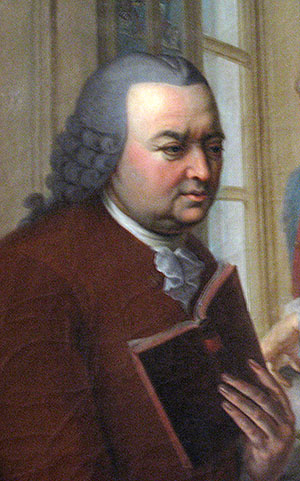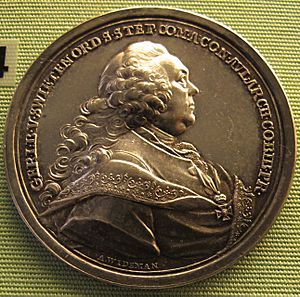Gerard van Swieten facts for kids
Quick facts for kids
Gerard van Swieten
|
|
|---|---|
 |
|
| Born | 7 May 1700 |
| Died | 18 June 1772 (aged 72) |
| Nationality | Dutch |
| Alma mater | Leiden University (M.D., 1725) University of Leuven |
| Scientific career | |
| Fields | Medicine, pharmacy |
| Thesis | De arteriae fabrica et efficacia in corpore humano (1725) |
| Doctoral advisor | Bernhard Siegfried Albinus |
| Other academic advisors | Herman Boerhaave |
| Doctoral students | Anton von Störck |
| Other notable students | Nikolaus von Jacquin |
Gerard van Swieten (born May 7, 1700 – died June 18, 1772) was a doctor from the Netherlands. From 1745, he became the personal doctor to Empress Maria Theresa of the Holy Roman Empire. He made big changes to Austria's healthcare and medical schools. He was also the father of Gottfried van Swieten, who supported famous musicians like Joseph Haydn, Wolfgang Amadeus Mozart, and Ludwig van Beethoven.
Contents
Early Life and Education
Gerard van Swieten was the only child to survive in a well-known Catholic family in Leiden, a city in the Netherlands. His parents, Thomas van Swieten and Elisabeth Loo, had their children baptized by Jesuit priests. Gerard remained a Roman Catholic his whole life. His family had been important citizens in Leiden since the 1400s.
Gerard was a very smart student. He finished Latin school when he was just 12 years old. Around that time, in 1712, he became an orphan. His father had chosen two friends, Adriaan Duyvens and Arnold Coops, to be his guardians. Gerard lived at Coops' house in Leiden until 1727.
He started studying philosophy at Leiden University. When he was 14, he also studied for a few months in Leuven. From 1715, he decided to focus on pharmacy. He worked as a student with a pharmacist in Amsterdam. He stopped this training when he got smallpox.
Back in Leiden, he joined the University again. He also became a student with another pharmacist, Nicolaas Stam. After three years, in 1720, he became a pharmacist. For the next five years, he ran a pharmacy and studied medicine at Leiden University. He mainly learned from two famous professors, Herman Boerhaave and Bernhard Siegfried Albinus. In July 1725, he earned his medical doctorate. His special project was about how arteries work in the human body.
A Doctor in Leiden
After becoming a doctor, Van Swieten started his own medical practice in Leiden. At first, he also kept running his pharmacy. But in 1727, he gave the pharmacy to a son of his guardian. He saw many patients and soon began giving private lessons. He taught about pharmacy and medicines. His first class had 60 students from Britain!
He was never officially allowed to teach these private classes. In 1734, the university told him to stop. Even so, within a year or two, he earned enough money to buy a grand house.
Van Swieten greatly admired his teacher, Boerhaave. He kept attending Boerhaave's classes even after finishing his own studies. He took many notes. People say he only missed one lecture between 1725 and 1738. Later, Van Swieten published these notes in five books.
When Boerhaave died in 1738, many people thought Van Swieten would take over his teaching job. He did take over some of Boerhaave's patients. However, he was not offered the professor's position. This was because Catholics were not allowed to be professors at Leiden University.
In September 1729, Van Swieten married Maria L. E. T. ter Beeck van Coesfelt. She was the daughter of a notary from The Hague. They had a very happy marriage. Between 1731 and 1746, they had six children. Five were born in Leiden and one in Vienna. Their oldest son, Godfried, became famous later. He was an Austrian ambassador and supported great classical music composers.
In 1742, the personal doctor of Empress Maria Theresa died. Because Van Swieten was Catholic and a top student of Boerhaave, he was offered this job. He was also offered the job of director of the court library. At first, he said no. He wrote to a friend that he preferred to stay "a small republican" rather than have a fancy title that hid a "slavish existence."
After a year and a half of being asked, Van Swieten finally accepted the offer in October 1744. Before his acceptance letter arrived, he was called to Brussels. Maria Theresa's younger sister, Maria Anna, was very sick. Maria Anna did not get better and died in December. But Van Swieten's quick response and confident actions impressed Maria Theresa. By May 1745, the Van Swieten family had sold everything in the Netherlands and moved to Vienna.
Career in Austria
In his new role, Gerard van Swieten changed Austria's healthcare system and medical education. He suggested a major health reform for the Habsburg monarchy. This reform, called "Generale Normativum in Re Sanitatis," was put into action by Maria Theresa in 1770. He started a botanical garden, a chemistry lab, and began teaching medical students in hospitals. From 1745, he also worked as the librarian for Maria Theresa at the Imperial Library.
Besides his work in medicine, Gerard van Swieten was also a reformer. He changed how censorship was handled. He removed the Jesuits who were in charge of censorship before him. He tried to make censorship more centralized. He also tried to use scientific and logical ideas to decide what literature was allowed.
Fighting Superstition: Vampires
Van Swieten played a very important role in fighting against superstition during the Age of Enlightenment. This was especially true for the stories about vampires. These stories were reported from villages in Serbia between 1718 and 1732.
After a war between Austria and Turkey ended in 1718, northern Serbia and parts of Bosnia came under Austrian control. People who moved to these new border areas brought vampire stories with them. These stories then spread to German-speaking areas for the first time.
In 1755, Empress Maria Theresa sent Gerard van Swieten to Moravia to look into the vampire situation. He believed the vampire myth was just "barbarism of ignorance." His goal was to get rid of these beliefs.
His report, called Abhandlung des Daseyns der Gespenster (which means Discourse on the Existence of Ghosts), gave scientific reasons for why people believed in vampires. He said that claims of strange things happening around graves could be explained by natural processes. For example, fermentation and lack of oxygen could stop bodies from decaying normally.
He wrote in his 1768 essay that "all the fuss doesn't come from anything other than vain fear, superstitious credulity, dark and eventful imagination and simplicity and ignorance among these people." Because of his report, Maria Theresa made a rule that banned all the old ways locals used to deal with accused vampires. This included putting them on stakes, beheading them, or burning them.
In 1758, he also looked into the case of Magda Logomer. She was a woman in Zagreb who was sentenced to death for witchcraft. Maria Theresa asked Van Swieten to examine her. His work led the queen to cancel the verdict. This helped end a period of witch trials in Croatia.
Honors
In May 1749, Van Swieten was chosen to be a Fellow of the Royal Society. This is a very respected group of scientists. In 1751, he became a foreign member of the Royal Swedish Academy of Sciences.
A type of mahogany tree was named after Gerard van Swieten. It is called Swietenia. This was done by a scientist named Nikolaus Joseph von Jacquin.
There is also a series of lectures named after him, called the Frank – van Swieten Lectures. These are international courses about managing information in hospitals. They are organized by several universities.
See also
 In Spanish: Gerard van Swieten para niños
In Spanish: Gerard van Swieten para niños



